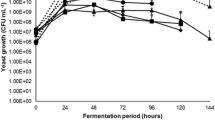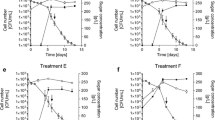Abstract
The role of the initial concentration of anaerobic growth factors (AGF) on interactions between Torulaspora delbrueckii and Saccharomyces cerevisiae was investigated in strict anaerobiosis. Experiments were performed in a synthetic grape must medium in a membrane bioreactor, a special tool designed for studying direct and indirect interactions between microorganisms. In pure culture fermentations, increased AGF concentration had no impact on S. cerevisiae behaviour, whereas it induced an extension of T. delbrueckii latency. Surprisingly, T. delbrueckii used only 75 to 80% of the consumed sugar to produce biomass, glycerol and ethanol. Physical separation influenced the population dynamics of co-fermentations. S.cerevisiae dominated the co-cultures having a single dose of AGF as its presence indirectly induced a decrease in numbers of living T. delbrueckii cells and physical contact with T. delbrueckii stimulated S.cerevisiae growth. Increasing the AGF initial concentration completely upset this domination: S. cerevisiae growth was not stimulated and T. delbrueckii living cells did not decrease. Yeasts incorporate exogenous AGFs, which probably impact their response to competing yeasts. The increase in AGF might have induced changes in the lipid composition of the T. delbrueckii membrane, which would hinder its interaction with S. cerevisiae antimicrobial peptides. The initial concentration of anaerobic growth factors influenced co-culture fermentation population dynamics tremendously, thus highlighting a new way to monitor population evolution and eventually wine organoleptic properties.





Similar content being viewed by others
References
Pretorius IS (2000) Tailoring wine yeast for the new millennium: novel approaches to the ancient art of winemaking. Yeast 16:675–729
Ciani M, Comitini F, Mannazzu I, Domizio P (2010) Controlled mixed culture fermentation: a new perspective on the use of non-Saccharomyces yeasts in winemaking. FEMS Yeast Res 10:123–133
Sadoudi M, Tourdot-Maréchal R, Rousseaux S, Steyer D. Gallardo-Chacón JJ, Ballester J, Vichi S, Guérin-Schneider R, Caixach J, Alexandre H (2012) Yeast–yeast interactions revealed by aromatic profile analysis of Sauvignon Blanc wine fermented by single or co-culture of non-Saccharomyces and Saccharomyces yeasts. Food Microbiol 32:243–253
Taillandier P, Lai QP, Julien-Ortiz A, Brandam C (2014) Interactions between Torulaspora delbrueckii and Saccharomyces cerevisiae in wine fermentation: influence of inoculation and nitrogen content. World J Microbiol Biotechnol 30:1959–1967
Contreras A, Curtin C, Varela C (2015) Yeast population dynamics reveal a potential ‘collaboration’ between Metschnikowia pulcherrima and Saccharomyces uvarum for the production of reduced alcohol wines during Shiraz fermentation. Appl Microbiol Biotechnol 99:1885–1895
Ciani M, Maccarelli F (1997) Oenological properties of non-Saccharomyces yeasts associated with wine-making. World J Microbiol Biotechnol 14:199–203
Ciani M, Picciotti G (1995) The growth kinetics and fermentation behaviour of some non-Saccharomyces yeasts associated with wine-making. Biotechnol Lett 17:1247–1250
Renault P, Miot-Sertier C, Marullo P, Hernández-Orte P, Lagarrigue L, Lonvaud-Funel A, Bely M (2009) Genetic characterization and phenotypic variability in Torulaspora delbrueckii species: potential applications in the wine industry. Int J Food Microbiol 134:201–210
Brandam C, Lai QP, Julien-Ortiz A, Taillandier P (2013) Influence of oxygen on alcoholic fermentation by a wine strain of Torulaspora delbrueckii: kinetics and carbon mass balance. Biosci Biotechnol Biochem 77:1848–1853
Renault P, Coulon J, de Revel G, Barbe JC, Bely M (2015) Increase of fruity aroma during mixed T. delbrueckii/S. cerevisiae wine fermentation is linked to specific esters enhancement. Int J Food Microbiol 207:40–48
Bely M, Stoeckle P, Masneuf-Pomarède I, Dubourdieu D (2008) Impact of mixed Torulaspora delbrueckii–Saccharomyces cerevisiae culture on high-sugar fermentation. Int J Food Microbiol 122:312–320
Nissen P, Arneborg N (2003) Characterization of early deaths of non-Saccharomyces yeasts in mixed cultures with Saccharomyces cerevisiae. Arch Microbiol 180:257–263
Velázquez R, Zamora E, Álvarez ML, Hernández LM, Ramírez M (2015) Effects of new Torulaspora delbrueckii killer yeasts on the must fermentation kinetics and aroma compounds of white table wine. Front Microbiol 6:1222
Ramírez M, Velázquez R, Maqueda M, López-Piñeiro A, Ribas JC (2015) A new wine Torulaspora delbrueckii killer strain with broad antifungal activity and its toxin-encoding double-stranded RNA virus. Front Microbiol 6:983
Rodriguez-Cousino N, Maqueda M, Ambrona J, Zamora E, Esteban R, Ramírez M (2011) A New Wine Saccharomyces cerevisiae Killer Toxin (Klus), encoded by a double-stranded RNA virus, with broad antifungal activity is evolutionarily related to a chromosomal host gene. Appl Environ Microbiol 77:1822–1832
Albergaria H, Francisco D, Gori K, Arneborg N, Gírio F (2010) Saccharomyces cerevisiae CCMI 885 secretes peptides that inhibit the growth of some non-Saccharomyces wine-related strains. Appl Microbiol Biotechnol 86:965–972
Branco P, Francisco D, Monteiro M, Almeida MG, Caldeira J, Arneborg N, Prista C, Albergaria H (2017) Antimicrobial properties and death-inducing mechanisms of saccharomycin, a biocide secreted by Saccharomyces cerevisiae. Appl Microbiol Biotechnol 101:159–171
Albergaria H, Arneborg N (2016) Dominance of Saccharomyces cerevisiae in alcoholic fermentation processes: role of physiological fitness and microbial interactions. Appl Microbiol Biotechnol 100:2035–2046
Holm Hansen E, Nissen P, Sommer P, Nielsen JC, Arneborg N (2001) The effect of oxygen on the survival of non-Saccharomyces yeasts during mixed culture fermentations of grape juice with Saccharomyces cerevisiae. J Appl Microbiol 91:541–547
Daum G, Lees ND, Bard M, Dickson R (1998) Biochemistry, cell biology and molecular biology of lipids of Saccharomyces cerevisiae. Yeast 14:1471–1510
Alexandre H, Rousseaux I, Charpentier C (1994) Relationship between ethanol tolerance, lipid composition and plasma membrane fluidity in Saccharomyces cerevisiae and Kloeckera apiculata. FEMS Microbiol Lett 124:17–22
Pina C, Santos C, Couto JA, Hogg T (2004) Ethanol tolerance of five non-Saccharomyces wine yeasts in comparison with a strain of Saccharomyces cerevisiae, influence of different culture conditions. Food Microbiol 21:439–447
Deytieux C, Mussard L, Biron MJ, Salmon JM (2005) Fine measurement of ergosterol requirements for growth of Saccharomyces cerevisiae during alcoholic fermentation. Appl Microbiol Biotechnol 68:266–271
Delfini C, Costa A (1993) Effects of the Grape must lees and insoluble materials on the alcoholic fermentation rate and the production of acetic acid, pyruvic acid, and acetaldehyde. Am J Enol Vitic 44:86–92
Rosi I, Bertuccioli M (1992) Influence of lipid addition on fatty acid composition of Saccharomyces cerevisiae and aroma characteristics of experimental wines. J Inst Brew 98:305–314
Lee AG (2004) How lipids affect the activities of integral membrane proteins. Biochim Biophys Acta BBA Biomembr 1666:62–87
Lees ND, Bard M, Kirsch DR (1997) In: Parish EJ, Nes WD (eds) Biochemistry and function of sterols, 1st edn. CRC Press, Boca Raton
Kleinhans FW, Lees ND, Bard M, Haak RA, Woods RA (1979) ESR determinations of membrane permeability in a yeast sterol mutant. Chem Phys Lipids 23:143–154
Loira I, Vejarano R, Bañuelos MA, Morata A, Tesfaye W, Uthurry C, Villa A, Cintora I, Suárez-Lepe JA (2014) Influence of sequential fermentation with Torulaspora delbrueckii and Saccharomyces cerevisiae on wine quality. LWT Food Sci Technol 59:915–922
Canonico L, Comitini F, Ciani M (2017) Torulaspora delbrueckii contribution in mixed brewing fermentations with different Saccharomyces cerevisiae strains. Int J Food Microbiol 259:7–13
Azzolini M, Fedrizzi B, Tosi E, Finato F, Vagnoli P, Scrinzi C, Zapparoli G (2012) Effects of Torulaspora delbrueckii and Saccharomyces cerevisiae mixed cultures on fermentation and aroma of Amarone wine. Eur Food Res Technol 235:303–313
Nissen P, Nielsen D, Arneborg N (2003) Viable Saccharomyces cerevisiae cells at high concentrations cause early growth arrest of non-Saccharomyces yeasts in mixed cultures by a cell-cell contact-mediated mechanism. Yeast 20:331–341
Brandam C, Fahimi N, Taillandier P (2016) Mixed cultures of Oenococcus oeni strains: a mathematical model to test interaction on malolactic fermentation in winemaking. LWT Food Sci Technol 69:211–216
Lopez CLF, Beaufort S, Brandam C, Taillandier P (2014) Interactions between Kluyveromyces marxianus and Saccharomyces cerevisiae in tequila must type medium fermentation. World J Microbiol Biotechnol 30:2223–2229
Salgado ME, Albasi C, Riba JP (2000) A two-reservoir, hollow-fiber bioreactor for the study of mixed-population dynamics: design aspects and validation of the approach. Biotechnol Bioeng 69:401–408
Salmon JM, Barre P (1998) Improvement of nitrogen assimilation and fermentation kinetics under enological conditions by derepression of alternative nitrogen-assimilatory pathways in an industrial Saccharomyces cerevisiae strain. Appl Environ Microbiol 64:3831–3837
Albasi C, Tataridis P, Salgado Manjarrez E, Taillandier P (2001) A new tool for the quantification of microorganism interaction dynamics. Ind Eng Chem Res 40:5222–5227
Jimenez RR, Ladha JK (1993) Automated elemental analysis: a rapid and reliable but expensive measurement of total carbon and nitrogen in plant and soil samples. Commun Soil Sci Plant Anal 24:1897–1924
Racine JS (2012) RStudio: a platform-independent IDE for R and Sweave. J Appl Econom 27:167–172
Rodriguez RJ, Low C, Bottema CD, Parks LW (1985) Multiple functions for sterols in Saccharomyces cerevisiae. Biochim Biophys Acta BBA-Lipids Lipid Metab 837:336–343
Lucero HA, Robbins PW (2004) Lipid rafts–protein association and the regulation of protein activity. Arch Biochem Biophys 426:208–224
Souza CM, Pichler H (2007) Lipid requirements for endocytosis in yeast. Biochim Biophys Acta BBA Mol Cell Biol Lipids 1771:442–454
Valdez-Taubas J, Pelham HRB (2003) Slow diffusion of proteins in the yeast plasma membrane allows polarity to Be maintained by endocytic cycling. Curr Biol 13:1636–1640
Viegas CA, Rosa MF, Sá-Correia I, Novais JM (1989) Inhibition of yeast growth by octanoic and decanoic acids produced during ethanolic fermentation. Appl Environ Microbiol 55:21–28
Renault PE, Albertin W, Bely M (2013) An innovative tool reveals interaction mechanisms among yeast populations under oenological conditions. Appl Microbiol Biotechnol 97:4105–4119
Mauricio JC, Millán C, Ortega JM (1998) Influence of oxygen on the biosynthesis of cellular fatty acids, sterols and phospholipids during alcoholic fermentation by Saccharomyces cerevisiae and Torulaspora delbrueckii. World J Microbiol Biotechnol 14:405–410
Tronchoni J, Curiel JA, Morales P, Torres-Pérez R, Gonzalez R (2017) Early transcriptional response to biotic stress in mixed starter fermentations involving Saccharomyces cerevisiae and Torulaspora delbrueckii. Int J Food Microbiol 241:60–68
Rivero D, Berná L, Stefanini I, Baruffini E, Bergerat A, Csikász-Nagy A, De Filippo C, Cavalieri D (2015) Hsp12p and PAU genes are involved in ecological interactions between natural yeast strains: Natural yeast interactions. Environ Microbiol 17:3069–3081
Barbosa C, Mendes-Faia A, Lage P, Mira NP, Mendes-Ferreira A (2015) Genomic expression program of Saccharomyces cerevisiae along a mixed-culture wine fermentation with Hanseniaspora guilliermondii. Microb Cell Factories 14:124
Hernández-López MJ, Pallotti C, Andreu P, Aguilera J, Prieto JA, Randez-Gil F (2007) Characterization of a Torulaspora delbrueckii diploid strain with optimized performance in sweet and frozen sweet dough. Int J Food Microbiol 116:103–110
Branco P, Viana T, Albergaria H, Arneborg N (2015) Antimicrobial peptides (AMPs) produced by Saccharomyces cerevisiae induce alterations in the intracellular pH, membrane permeability and culturability of Hanseniaspora guilliermondii cells. Int J Food Microbiol 205:112–118
Lichtenstein A, Ganz T, Selsted ME, Lehrer RI (1986) In vitro tumor cell cytolysis mediated by peptide defensins of human and rabbit granulocytes. Blood 68:1407–1410
Pandey BK, Srivastava S, Singh M, Ghosh JK (2011) Inducing toxicity by introducing a leucine-zipper-like motif in frog antimicrobial peptide, magainin 2. Biochem J 436:609–620
Brogden KA (2005) Antimicrobial peptides: pore formers or metabolic inhibitors in bacteria? Nat Rev Microbiol 3:238
Harris F, Dennison S, Phoenix D (2009) Anionic Antimicrobial Peptides from Eukaryotic Organisms. Curr Protein Pept Sci 10:585–606
Kagan BL, Ganz T, Lehrer RI (1994) Defensins: a family of antimicrobial and cytotoxic peptides. Toxicology 87:131–149
Gallo M, Katz E (1972) Regulation of secondary metabolite biosynthesis: catabolite repression of phenoxazinone synthase and actinomycin formation by glucose. J Bacteriol 109:659–667
Acknowledgements
This work was financially supported by the French Ministry of Higher Education and Research. The authors thank Agathe Juppeau for providing excellent technical assistance.
Author information
Authors and Affiliations
Corresponding author
Ethics declarations
Conflict of interest
The authors declare that they have no conflict of interest.
Human and animal rights
This article does not contain any studies with human or animal subjects.
Rights and permissions
About this article
Cite this article
Brou, P., Taillandier, P., Beaufort, S. et al. Mixed culture fermentation using Torulaspora delbrueckii and Saccharomyces cerevisiae with direct and indirect contact: impact of anaerobic growth factors. Eur Food Res Technol 244, 1699–1710 (2018). https://doi.org/10.1007/s00217-018-3095-3
Received:
Revised:
Accepted:
Published:
Issue Date:
DOI: https://doi.org/10.1007/s00217-018-3095-3




